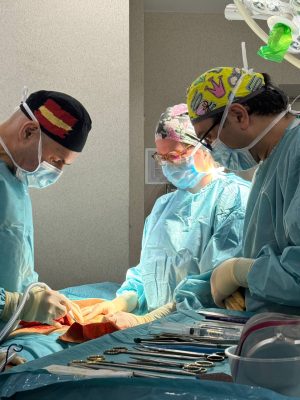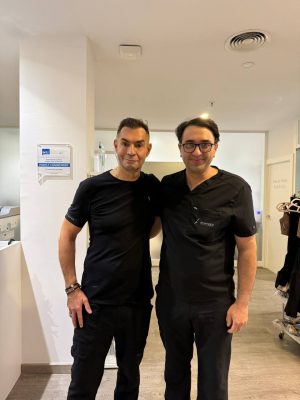Hourglass body shape surgery in Iran
Hourglass body shape surgery in Iran refers to a combination of cosmetic procedures aimed at achieving a more defined waist and balanced proportions between the shoulders, waist, and hips, resembling an “hourglass” figure. This type of surgery can involve various techniques, depending on the individual’s body type and aesthetic goals. Below are some of the most common procedures involved in creating or enhancing an hourglass figure:
1. Breast Augmentation or Lift
To balance the upper body with the hips, breast augmentation or lifts are often performed. This can involve implants or fat transfer to increase size, enhance shape, or lift sagging breasts.
2. Liposuction
Liposuction removes excess fat from specific areas to sculpt the body. It is commonly used on the waist, abdomen, lower back, and thighs to accentuate the waistline and reduce the circumference of these areas, helping to create a more pronounced hourglass shape.
3. Tummy Tuck (Abdominoplasty)
A tummy tuck removes excess skin and fat from the abdomen and tightens the abdominal muscles. This procedure is particularly beneficial for those who have loose skin after weight loss or pregnancy and want a firmer, flatter abdomen.
4. Brazilian Butt Lift (BBL) or Butt Implants
To enhance the lower curves and create a balance with the upper body, a Brazilian Butt Lift (BBL) transfers fat from other areas of the body (like the abdomen, hips, and thighs) into the buttocks. For those who lack sufficient fat for transfer, butt implants may be an alternative.
5. Hip Augmentation
Fat transfer or implants can also be used to increase the width and curves of the hips, further enhancing the hourglass appearance.
Considerations Before Surgery
– Consultation: A thorough consultation with a qualified plastic surgeon is essential. The surgeon will evaluate your body type, discuss your goals, and recommend a combination of procedures that can best achieve the desired outcome.
– Realistic Expectations: Understanding the potential results and limitations of surgery is crucial. Not everyone will achieve the same results, and outcomes depend significantly on individual body types and conditions.
– Health and Safety: Ensure you are in good health before undergoing surgery. Discuss any medical conditions or medications with your surgeon.
– Recovery: Recovery can vary depending on the extent of the surgery. It may involve wearing compression garments, taking time off work, and avoiding strenuous activities for several weeks.
– Costs and Logistics: These surgeries can be costly and are often not covered by insurance as they are considered cosmetic. Planning for the financial aspect and the recovery period is necessary.
Risks and Potential Complications
Like all surgical procedures, surgeries to create an hourglass figure carry risks such as infection, scarring, complications from anesthesia, and dissatisfaction with the aesthetic results. Discussing these risks with your surgeon beforehand is important.
Post-Operative Care
Proper post-operative care is crucial for optimal results and includes following the surgeon’s instructions for care, attending follow-up appointments, and managing pain and swelling.
Overall, achieving an hourglass body shape through surgery requires careful planning, skilled surgical execution, and realistic expectations about the outcomes. It’s a personal decision that should be made with comprehensive information and professional guidance.
Rib reshaping surgery for a slimmer waist
Rib reshaping surgery, often referred to as rib removal surgery, is a highly invasive and controversial cosmetic procedure aimed at achieving a slimmer waistline by physically removing one or more of the lower ribs. This procedure is sometimes sought by individuals looking to enhance the hourglass figure by narrowing the waist to create more dramatic curves.
Overview of Rib Reshaping Surgery
Procedure Details:
– Surgical Approach: The surgery involves the removal of the floating ribs, typically the 11th and 12th ribs, which are not attached to the sternum or other ribs directly. These ribs are accessed through incisions made in the back or under the rib cage.
– Anesthesia: Rib removal is performed under general anesthesia.
– Duration and Recovery: The surgery can take several hours, and recovery time varies. Patients may need several weeks to fully recover, with potential restrictions on physical activity.
Risks and Complications:
– Infection and Bleeding: As with any surgery, there is a risk of infection and significant bleeding.
– Structural Changes and Instability: Removing ribs can alter the natural structure of the rib cage, which may affect the protective function it serves for vital organs.
– Chronic Pain: The procedure can lead to long-term pain or discomfort in the site of surgery.
– Breathing Issues: Since the ribs play a critical role in breathing mechanics, their removal could potentially impact respiratory function.
Considerations and Alternatives
Ethical and Medical Considerations:
– Medical Necessity: Most medical professionals advise against this surgery for purely aesthetic reasons due to its risks and the ethical considerations of removing structurally significant bones.
– Psychological Impact: Potential patients must undergo thorough psychological evaluation to ensure they have realistic expectations and sound reasons for seeking such drastic body modification.
Alternatives:
– Waist Training: Using corsets or waist trainers to gradually reduce waist size. This method is less invasive but requires consistent and long-term use.
– Diet and Exercise: Targeted exercise programs and a healthy diet can help reduce body fat overall and tone the waist area, although they cannot change bone structure.
– Liposuction: Removing fat from around the waist and abdomen to create a slimmer appearance without altering the bone structure.
Conclusion
Rib reshaping surgery for a slimmer waist is a significant and risky procedure with potential long-term implications. It’s crucial for anyone considering this surgery to discuss all possible alternatives, risks, and benefits with a qualified plastic surgeon and possibly seek a second opinion. Moreover, understanding the motivations behind seeking such a procedure is important, as body image issues may also require psychological support or counseling.
Post-surgery compression garment for Hourglass body shape surgery in Iran
Post-surgery compression garments play a crucial role in the recovery process after undergoing procedures aimed at sculpting an hourglass body shape, such as liposuction, tummy tucks, Brazilian Butt Lifts (BBL), and other related surgeries. These garments help to reduce swelling, provide support to the surgical areas, and assist in the body’s natural healing process. Here’s a detailed look at their features, benefits, and guidelines for use:
Features of Compression Garments
– Material: Typically made from a high-stretch, breathable fabric that applies even compression without causing skin irritation or excessive sweating.
– Design: They come in various styles, including full-body suits, high-waisted shorts, girdles, and bodysuits, often with zippers or hooks for ease of wearing and adjustment.
– Fit: Designed to fit snugly but comfortably, ensuring that the pressure is evenly distributed across the treated areas.
Benefits of Using Compression Garments
– Reducing Swelling and Bruising: By applying gentle pressure, these garments help reduce the body’s natural swelling and bruising post-surgery.
– Supporting and Stabilizing: They provide support to the surgical areas, helping tissues to heal correctly and potentially improving the overall contour of the body.
– Enhancing Blood Circulation: Improved blood flow aids in faster recovery and reduces the risk of complications such as blood clots.
– Controlling Pain: Compression can help contain the surgical area and reduce movements that might cause pain during the healing process.
Guidelines for Use
– Duration of Use: The duration for which a compression garment should be worn varies depending on the surgery and the surgeon’s advice. Generally, it is recommended for several weeks 24/7, except during bathing.
– Right Size: It’s vital to wear the correct size of compression garment. An overly tight garment can impede circulation, while a loose one may fail to provide the necessary support. Sizes should be chosen or adjusted based on the swelling reduction over time.
– Care and Maintenance: Regular washing in accordance with manufacturer instructions is essential for hygiene and maintaining the garment’s elasticity.
– Follow-Up Consultations: Regular check-ups with the surgeon are necessary to ensure the recovery is progressing well and to adjust the compression garment’s use as needed.
Tips for Choosing the Right Garment
– Consult Your Surgeon: Before purchasing a garment, discuss options with your surgeon since they can recommend the best type and fit for your specific needs.
– Quality Matters: Invest in a high-quality garment that will maintain its shape and compression over the weeks you’ll need to wear it.
– Comfort is Key: Since the garment will be worn for extended periods, ensure it has features like flat seams to avoid skin irritation and adjustable closures for changing body shape due to swelling reduction.
Conclusion
Post-surgery compression garments are an integral part of the recovery process for surgeries designed to create or enhance an hourglass figure. They not only facilitate a quicker recovery by reducing complications and discomfort but also help in achieving the desired aesthetic results. Proper use, consistent wear, and careful maintenance of the garment are essential for its effectiveness.
Buttock prosthesis surgery
Buttock prosthesis surgery, commonly known as buttock augmentation or gluteal augmentation with implants, is a cosmetic procedure designed to enhance the size and shape of the buttocks using artificial implants. This procedure is an option for those seeking more prominent, shapely buttocks when methods such as fat grafting (Brazilian Butt Lift) are not suitable, typically due to a lack of sufficient body fat for transfer or for individuals seeking a more permanent solution.
Overview of Buttock Prosthesis Surgery
Procedure Steps:
1. Consultation: The first step involves a consultation with a plastic surgeon to discuss goals, the available implant types, sizes, and the potential risks and outcomes of the surgery.
2. Anesthesia: Buttock implant surgery is typically performed under general anesthesia.
3. Incision: The surgeon makes incisions where the implants will be inserted. Common incision sites are in the crease between the buttocks (to minimize visible scarring), at the top of the buttock, or down the buttock crease vertically.
4. Insertion and Placement: The implants can be placed either above or below the gluteal muscle (submuscular or subfascial placement). Submuscular placement is often preferred as it provides more coverage of the implant, reducing the risk of complications and creating a more natural appearance.
5. Closing Incisions: The incisions are closed with sutures, and drains may be placed to remove excess fluid.
6. Recovery: Post-operative care involves managing pain, preventing infection, and allowing the implants to stabilize within the buttocks.
Advantages of Buttock Prosthesis Surgery
– Volume and Shape Enhancement: Provides significant enhancement in both size and shape, creating a more pronounced and aesthetically pleasing buttock contour.
– Permanence: Unlike fat transfer, which may reabsorb over time, implants do not diminish in size and shape.
– Suitability: Ideal for individuals who do not have enough body fat for a Brazilian Butt Lift.
Risks and Potential Complications
– Infection and Bleeding: As with any surgical procedure, there is a risk of infection and bleeding.
– Implant Displacement: The implant may shift from its original position, potentially requiring revision surgery.
– Capsular Contracture: The formation of tight scar tissue around the implant, which might cause discomfort or an unnatural appearance.
– Visible or Palpable Implants: Especially in very lean patients, implants may be more noticeable.
Post-Surgery Care and Recovery
– Rest and Limited Movement: Patients are typically advised to avoid sitting directly on the buttocks or lying on their back for several weeks after the surgery.
– Compression Garments: Wearing a compression garment can help reduce swelling and support the new contours of the buttocks.
– Activity Restrictions: Strenuous activities and exercise should be avoided for about 4-6 weeks post-surgery.
– Follow-up Appointments: Essential for monitoring the healing process and the position of the implants.
Conclusion
Buttock prosthesis surgery can significantly enhance the appearance of the buttocks, providing long-lasting results. However, it is a major surgical procedure that carries certain risks and requires careful consideration and consultation with a qualified plastic surgeon. Understanding both the benefits and potential complications is crucial for anyone considering this type of cosmetic surgery.




